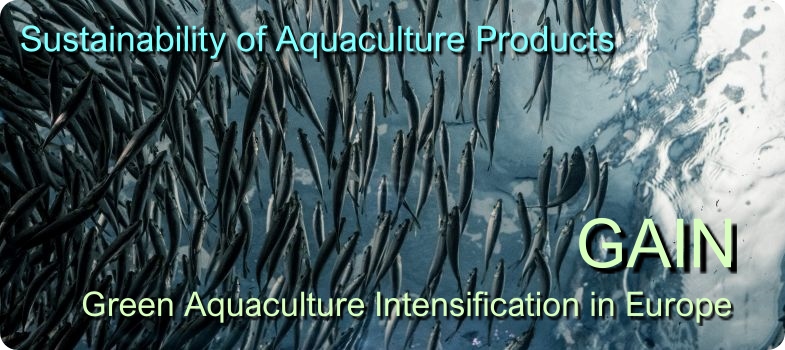Credits and acknowledgements
Authorship
The "Sustainability and Aquaculture" Unit was
written by Dr Richard Newton, Dr Sonia Rey-Planellas and Professor David Little at the Institute of Aquaculture, University of Stirling, UK.
Video
The video "The Potential of Fish By-Products" was produced by the Institute of Aquaculture at the University of Stirling from a podcast of the same title. Full details at https://www.susaquastirling.net/hotfishpodcasts/episode007. It is made availble through the standard YouTube License.
The video "Social considerations for sustainable aquaculture" was developed and produced by David Little. It is made availble through the standard YouTube License.
The video "Thailand's Seafood Slaves" was produced by the Environmental Justice Foundation and uploaded on 30th November 2015. It is made availble through the standard YouTube License.
The video "Principles of animal welfare as they apply to fish" was developed and produced by Sonia Rey Planellas. It is made availble through the standard YouTube License.
Figures
Figure 1. Global
catches of most important species groups for the marine ingredients industry
1967 – 2017. This chart was generated using Microsoft Excel from data extracted from FAO. 2021. Fishery and Aquaculture Statistics. Global capture production 1950-2019 (FishstatJ). In: FAO Fisheries Division [online]. Rome. Updated 2021. www.fao.org/fishery/statistics/software/fishstatj/en It is icensed under Creative Commons Attribution-NonCommercial-ShareAlike 3.0 IGO (CC BY-NC-SA 3.0 IGO).
Figure 2. Land use change in Brazil from 2000 to 2017
linked to soyabean and cattle ranching (Darker area is forest). From "Making Sense of Amazon Deforestation Patterns" by Adam Voiland, Published on the NASA Earth Observatory. Landsat image courtesy of the U.S. Geological Survey (Public Domain).
Figure 3. a)
% Water used for agriculture, b) Global water scarcity factor (WTA*);
extraction to availability. These figures are reproduced from the Supplementary Information of Pfister, S.,
Koehler, A. & Hellweg, S. (2009) Assessing the environmental impacts of
freshwater consumption in LCA. Environ
Sci Technol, 43, 4098-104. https://doi.org/10.1021/es802423e
Figure 4. Carbon footprint of 1 tonne of selected feed ingredients. Chart created in Microsoft Excel using GAIN unpublished data and EcoInvent 3.0. It is licenced under Creative Commons 4.0 cc-by-nc-sa.
Figure 5. Pathways leading to eutrophication and benthic impact at marine cage farms. Reproduced from Wang, X., Olsen, L.M., Reitan, K.I., Olsen, Y., 2012. Discharge of nutrient wastes from salmon farms : environmental effects , and potential for integrated multi-trophic aquaculture. Aquac. Environ. Interact. 2, 267–283. https://doi.org/10.3354/aei00044 Copyright © 2012 Inter-Research.
Figure 6. Summary of global seafood value chains in terms of economic value. Graphic provided by Dr Malcolm Beveridge based on FAO data and used in unpublished presentations in 2016. It is licenced under Creative Commons 4.0 cc-by-nc-sa.
Figure 7. Map of the globe with countries resized to represent aquaculture prodution output (2008). This is reproduced from Hall, S.J., A. Delaporte, M. J. Phillips, M. Beveridge and M. O’Keefe. 2011. Blue Frontiers: Managing the Environmental Costs of Aquaculture. The WorldFish Center, Penang, Malaysia. https://hdl.handle.net/20.500.12348/1145. Copyright WorldFish.
Figure 8. Map of the world with countries shaded to show the degree to which seafood contributes to total animal protein supply. From "The State of World Fisheries and Aquaculture", 2016. Food and Agriculture Organisation of the United Nations. https://www.fao.org/3/i5555e/i5555e.pdf. Copyright is held by the FAO.
Figure 9. Per capita consumption of seafood in European countries. This figure is from: The EU Fish Market 2020 Edition. European Market Observatory for Fisheries and Aquaculture Products. It is licenced under Creative Commons 4.0 cc-by
Figure 10. The importance of different seafood product attributes for UK consumers. This graphic is originally from "Exploring shopper behaviour when purchasing fresh fish and seafood: Category
benchmark report. IGD ShopperVista 2019” and was reproduced in Watson, R. 2019. Farmed Seafood in Multiple Retail (2019). Seafish Market Insight Factsheet. https://www.seafish.org/document/?id=11052a6f-6c8e-423c-8d8c-1c4fa696a68e. ©IGD 2019. All Rights Reserved.
Figure 11. Definition of "Coastal Indigenous People" study unit. This figure is from Cisneros-Montemayor et. al. 2016.
Figure 12. Locations of coastal indigenous people included in the analysis. This figure is from Cisneros-Montemayor et. al. 2016.
Figure 13. Consumption per capita for indigenous groups by global subregion. This figure is from Cisneros-Montemayor et. al. 2016.
Figure 14. Illustration of nodes, actors and institutions and linkages in the value chain approach. The figure is reproduced from Nygaard & Hansen, 2015, who cite the original source as Bolwig et. al 2010.
Figure 15. Newspaper headline on publication of a Seafood Watch report. This is a reproduction of part of an article published by The Guardian, 23 Jan 2018. Photo by Rungroj Yongrit/EPA. Copyright The Guardian.
Figure 16. Newspaper headline about investigation into labour practices in the Thai shrimp processing industry. This is a reproduction of part of an article published by The Guardian, 14 Dec 2015. Photo by Gemunu Amarasinghe/AP. Copyright The Guardian.
Figure 17. Key headings in the BAP Social Standards. This figure was developed by the course tutors based on the Global Seafood Alliance Best Aquaculture Practices. It is licenced under Creative Commons 4.0 cc-by-nc-sa.
Figure 18: The 5 freedoms for animal welfare. (source: Euractiv) https://www.euractiv.com/section/agriculture-food/infographic/animal-welfare-in-the-eu/ Copyright Euractiv.
Figure 19. International standards for animal welfare (source: World Organisation for Animal Health (OIE)) https://old.oie.int/infographic/StandardsAW/index.html. Permission granted to use and distribute freely.
Figure 20. Issues for welfare include stocking densities and exposure to predation (Photos by Sonia Rey Planellas and Jimmy Turnbull). It is licenced under Creative Commons 4.0 cc-by-nc-sa.
